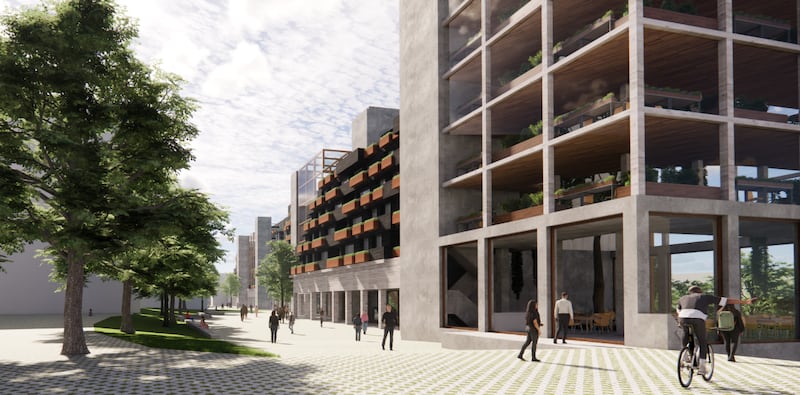The six schools of architecture in Ireland are carrying out a “radical transformation” of their curriculums to equip architects of the future to respond to the climate and housing crises, according to Peter Carroll, head of architecture at the School of Architecture at the University of Limerick.
The so-called Building Change initiative is a three-year project which started in April 2022 and is funded by the Higher Education Authority’s Human Capital initiative.
It seeks to embed the 17 UN Sustainable Development Goals and the Royal Institute of Architects of Ireland (RIAI) 2030 Climate Challenge into all modules in architecture courses at University College Dublin (UCD); the Technological University of Dublin (TU Dublin), University of Limerick, the South East Technological University, the Atlantic Technological University (ATU) and at the Cork Centre for Architectural Education.
“This represents a paradigm shift for architects compared to 20 years ago. It’s a unique opportunity for all schools of architecture to work together. I’ve never seen anything like it other parts of the world,” says John Bruen, the Building Change co-ordinator at the school of architecture at ATU in Sligo.
READ MORE
Carroll says that one of the main challenges in architecture education is to give agency to students so that they can deal with homelessness and extreme weather events when designing new buildings. “It’s about making students agile and not fearful of doing things differently.”
“It’s also about putting carbon neutrality, life-cycle analysis, the circular economy and designs for disassembly front and central in the architectural curriculum,” says Carroll.
He believes students need to be taught to look beyond current regulations (such as current maximum heights allowed for timber frame construction) in their designs so that they can be empowered to shape policy going forward.
Carroll also suggests that future deconstructed building should provide materials for new builds rather than the demolition waste created when 1960s and 1970s office buildings are torn down. As part of the Building Change project at UCD, students of architecture have opposed the redevelopment of the Stephen’s Green shopping centre in Dublin for retail and office use. Instead, they suggest more subtle remodelling rather than demolition to incorporate public space.
“It’s a place younger people go to hang out because there aren’t a lot of place to hang out in Dublin. Students recognise that it’s not a perfect building but that the answer is not to knock it,” says Hugh Campbell, professor of architecture at UCD. Objections to the shopping centre’s redevelopment – for which Dublin City Council granted planning permission in December 2023 – are currently with An Bord Pleanála.
Meanwhile, students at ATU have made a master plan for the harbour and marina at Killybegs in Co Donegal. In it, buildings and walkways are designed to cope with sea level rise and natural solutions to counteract flooding are incorporated into the plans. In another example of radical learning, fourth-year students of architecture at the Technological University of Dublin (TU Dublin) completed a 12-week project in which they developed four possible master plans for new student housing on the Grangegorman campus.

Currently, TU Dublin is unusual in that there isn’t any on-campus student accommodation in spite of high demand for bed spaces and large empty sites where such buildings could easily fit. The original master plan for Grangegorman included a proposal for 2,100 student beds – and fast-tracked through planning in 2012 – yet nothing has been built.
The urgent need for affordable student accommodation is palpable when you engage with students and the radical student housing projects envisaged by the fourth-year students at TU Dublin offer plenty of possible solutions to the student housing crisis.
The four master plans also exhibit the use of sustainable building materials (such as synthetic concrete and locally sourced cut stone), passive heating and ventilation systems and rainwater harvesting techniques which could alleviate flooding during extreme bouts of rainfall.
“Our master plan developed a carbon matrix of 15 elements and each student managed one element – eg heat conservation, energy production, etc. The whole process made us more conscious of the buildings beside the ones we were designing. The environment is now the biggest consideration for architects rather than just aesthetics,” explains Alex Dillon, fourth-year student of architecture at TU Dublin.
Including student accommodation in the 19th-century clock tower building, building bedrooms on floors over the east quad building and on top of the bus park next to the Grangegorman campus were some of the novel suggestions.
Constructing an iconic water tower which stored rainwater for backup capacity (and included a rooftop swimming pool) while also providing 120 bed spaces for students was another fascinating design. While most buildings were eight storeys or lower, one master plan included two taller buildings up to 30 storeys high. Retrofitting existing buildings near the campus (such as Park House on North Circular Road which is currently a temporary library) and creating more green space and accessibility for the local community were other key elements of designs.
“We also wanted to see if we could renovate or retrofit those buildings which are on our doorstep and are going to waste instead of solely focusing on new builds. And this fits in with the UN sustainable development goals in relation to both the climate crisis and the housing crisis,” says Christine Cruz who currently spends three hours a day commuting to and from college.
Dermot Boyd, senior lecturer in architecture at TU Dublin, says lecturers and students alike are conscious that the building industry is responsible for about 40 cent of carbon emissions when you include the production and use of cement, steel and aluminium (so-called embodied carbon) as well as operational carbon (heating, cooling and lighting buildings).
“It’s a wake-up call to radicalise our approach. It’s important that these [carbon] issues are addressed when designs are being conceived and that architects talk to clients about using more timber and less concrete,” Boyd adds.
Emma Geoghegan, head of architecture at TU Dublin, adds: “As finance starts to follow environmental imperatives, we have to make sure the next generation of architects is ready to build in an environmentally sustainable way and that they are climate literate so that they are able to calculate and account for the carbon in their designs.”
Geoghegan and Boyd acknowledge that the upskilling of staff has been central to the Building Change project with training courses on topics such as life-cycle design (where use, reuse and recycling of materials reduces end-of-life waste) have been held for lecturers in all six schools of architecture.
“The students were ahead of us at the beginning but we are also working with the RIAI and the national standards for the education of architects are currently being rewritten,” Geoghegan explains.
Carroll contends Ireland has one of the strongest architectural cultures in the world – with Irish architects winning internationally recognised awards for their work – and that the Building Change adds to the strength of that culture.
“The most important thing is designing a resilient future for architectural education and we believe that by bringing all schools of architecture together to do this, it’s the first initiative of its kind in the world,” he adds.
- Sign up for push alerts and have the best news, analysis and comment delivered directly to your phone
- Find The Irish Times on WhatsApp and stay up to date
- Listen to our Inside Politics podcast for the best political chat and analysis










